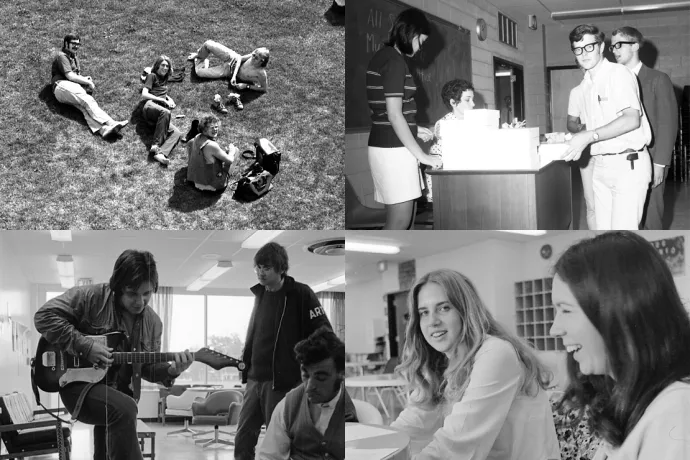
Snapshots in Time: Student journalists capture campus history
Whether revealing the true identity of an anonymous columnist or unearthing the origins of a renowned theatre program, student journalists are preserving U of T Mississauga history, one story at a time.
Now those stories live on in the 2020 edition of Compass, a journal produced by students in UTM’s Professional Writing and Communication (PWC) program.
Included in Compass are stories from students in History and Writing (WRI320), a semester-long upper year writing course led by lecturer Robert Price.
“This course teaches how to write about history,” says Price. Students learn the foundations of pitching a story, searching through archives and how to conduct interviews. With Price’s guidance, students then craft their research into a feature-length article.
Not all students in the course write about the campus, however, the wealth of information makes campus history an attractive topic, says Price. Ready access to alumni connections, campus archives and Heritage Mississauga resources help add vital details to a story.
Previously, students have written about Erindale College rally races around the city, and the histories of the families who owned the land where the university now stands. The project also provides a record of memories from alumni and former or current staff and faculty—the kind of personal stories that may be missing from official records.
“I'm amazed at the enormous effort the students put into documenting UTM's history,” Price says. “They want to know where our campus came from.”
Professional writing students Aaminah Khan and Morrigan Crotty are among those seized by an interest in campus history. Their stories, included in the latest issue of Compass, look back to the early days of Erindale College.
Who is Peabody?
Khan, who graduated from psychology and professional writing studies in 2019, turned to back issues of The Erindalian and Medium II to find inspiration for her story. It was there that she discovered “Peabody,” an anonymous student columnist who wrote for the student papers from 1973 to 1975.
Khan was intrigued by Peabody’s often cantankerous take on campus life during the early days of Erindale College. She sussed the authors real name—Neil Sherman (BA, 1975) but her research stalled until Khan visited the campus archives at the UTM Library where she found Sherman’s picture, listed with his middle initial, in a class composite photo. Some Internet sleuthing led her to Sherman’s American voting records and a home phone number.
“Are you Peabody?” Khan asked when she finally reached Sherman at his home in New England. The alumnus and former student journalist was surprised but happy to chat about his student journalism days, and how a favourite Erindale professor, Tom Adamowski, had influenced Sherman to become an English professor, too.
Khan’s connection with Peabody wasn’t a moment too soon. Sherman died of kidney failure in January 2020.
Theatre Erindale
Theatre fan Morrigan Crotty pulled back the curtain on the origins of Theatre Erindale and UTM’s theatre and drama program. Like Khan, Crotty also turned to the UTM archives where she puzzled over old timetables to find connections between courses and instructors.
She was rewarded with fascinating nuggets, like the architectural blueprints for theatre spaces. “I saw a blueprint for a theatre that was planned, but never actually came to fruition,” Crotty says. “It was supposed to be right outside of Davis, near the medical building.”
Crotty’s research also introduced her to Erindale College’s founding drama instructor John Astington who Crotty describes as “one of the few people who remembers all that hasn’t been written down.” Now retired, Astington was delighted to share anecdotes from the early days of the program. Their interview became the lead for Crotty’s story.
“I loved hearing about specific scenes that they were doing in class,” she says “You see how we began and how things evolved. It’s a glimpse of that time.”
Price, who is also a UTM alumnus and former Medium journalist, says that writing and researching the stories have an unexpected benefit—students often discover a newfound or deeper connection with the campus.
“They start understanding where the campus came from and how they fit into our campus's unfolding history,” Price says. “They discover a lot about the campus and see that we really have a vibrant history that is often lost, or forgotten.”
“The history is so fascinating,” Price continues. “But there are people associated with the campus who have died or left. New people come, and new history is laid down. If we don’t record those histories now, it will quickly be forgotten.”
Compass is available at the UTM Library.
Read more:
- The Pandemic Papers: UTM students make history with donation to Mississauga archives
- Queer in the Suburbs: Hidden histories of Peel Region
- UTM Timeline: From pastures to pedagogy
